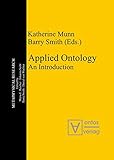Applied ontology : an introduction / [edited by] Katherine Munn, Barry Smith.
Material type: TextSeries: Metaphysical research ; Bd. 9.Publisher: Frankfurt : Ontos Verlag ; [2008]Distributor: Piscataway, NJ : [Distributed in] North and South America by Transaction Books, [2008]Copyright date: ©2008Description: 1 online resource (342 pages) : illustrationsContent type:
TextSeries: Metaphysical research ; Bd. 9.Publisher: Frankfurt : Ontos Verlag ; [2008]Distributor: Piscataway, NJ : [Distributed in] North and South America by Transaction Books, [2008]Copyright date: ©2008Description: 1 online resource (342 pages) : illustrationsContent type: - text
- computer
- online resource
- 9783110324860
- 3110324865
- 3938793988
- 9783938793985
- 9783110324501
- 3110324504
- 111 22
- BD311 .A87 2008
Title from PDF title page (viewed on July 25, 2013).
Introduction: What is ontology for? / Katherine Munn -- Bioinformatics and philosophy / Barry Smith and Bert Klagges -- What is formal ontology / Boris Hennig -- A primer on knowledge management and ontological engineering / Pierre Grenon -- New desiderata for biomedical terminologies / Barry Smith -- The benefits of realism: A Realist Logic with Applications / Barry Smith -- A theory of granular partitions / Thomas Bittner and Barry Smith -- Classifications / Ludger Jansen -- Categories: The Top-Level Ontology / Ludger Jansen -- The classification of living beings / Peter Heuer and Boris Hennig -- Ontological relations / Ulf Schwarz and Barry Smith -- Four kinds of "Is_A" relation / Ingvar Johansson -- Occurrents / Boris Hennig -- Bioinformatics and biological reality / Ingvar Johansson.
Includes bibliographical references (pages 311-327) and index.
Ontology is the philosophical discipline which aims to understand how things in the world are divided into categories and how these categories are related together. This is exactly what information scientists aim for in creating structured, automated representations, called 'ontologies, ' for managing information in fields such as science, government, industry, and healthcare. Currently, these systems are designed in a variety of different ways, so they cannot share data with one another. They are often idiosyncratically structured, accessible only to those who created them, and unable to serve.
Open Access EbpS

There are no comments on this title.